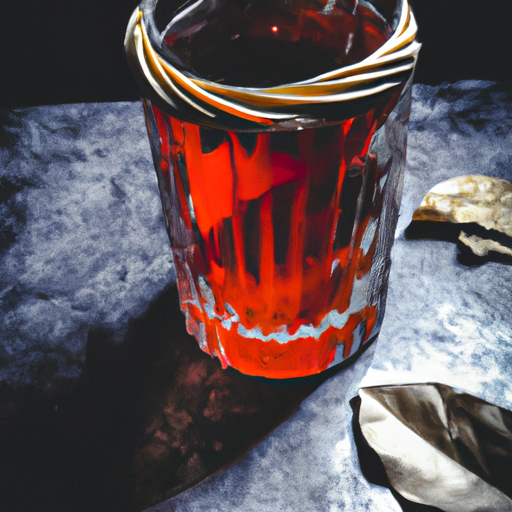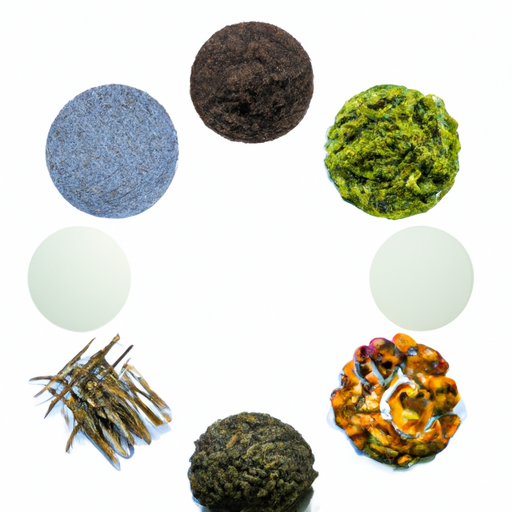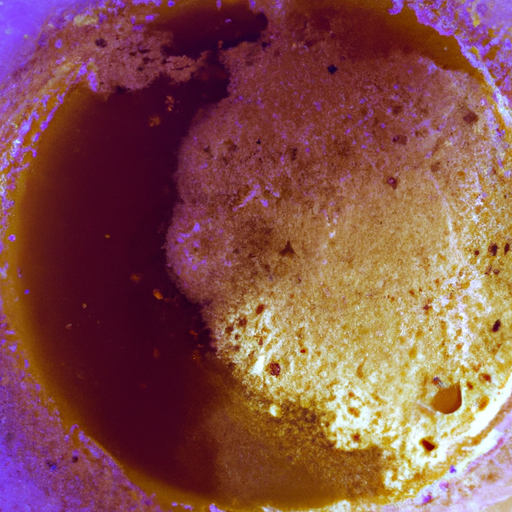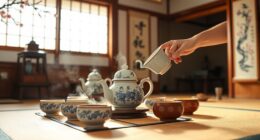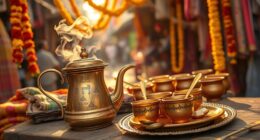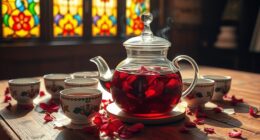To brew classic tea year-round, adjust your techniques seasonally. Store your tea in airtight containers away from light, heat, and moisture, and keep it cool or refrigeration during warmer months. Use hotter water in winter to extract full flavors, and cooler water in summer for lighter, invigorating brews. Warming your teapot and choosing the right temperature for each season enhances your experience. Keep exploring these tips to perfect your seasonal tea routine.
Key Takeaways
- Adjust brewing temperatures seasonally: hotter in winter (200-212°F) for robust flavor, cooler in summer (160-185°F) for lighter taste.
- Store tea properly in airtight containers away from light, heat, and moisture, and refrigerate in summer for freshness.
- Use season-specific techniques, such as pre-warming teapots in winter and chilling brewed tea in summer.
- Select tea types and steeping times suited to season and personal preferences to enhance flavor.
- Incorporate small seasonal adjustments, like cooling or warming, to elevate the tea-drinking experience year-round.
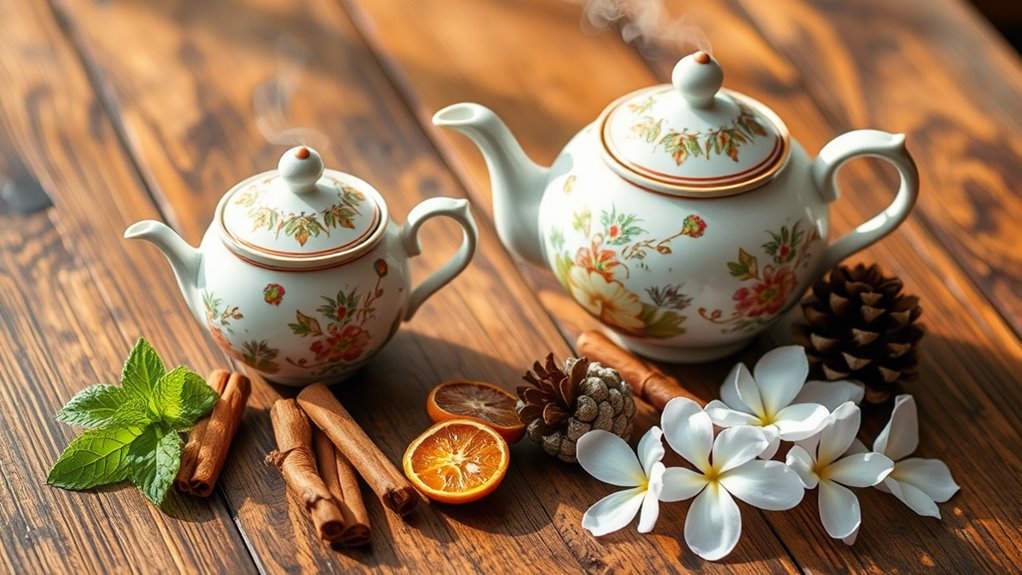
Tea brewing varies with the seasons, and adjusting your techniques can enhance both flavor and comfort year-round. As the weather changes, so should your approach to preparing tea, especially when it comes to tea storage and brewing temperature. Proper tea storage keeps your leaves fresh, preserving their natural aromas and flavors. Keep your tea in airtight containers away from light, heat, and moisture, which can degrade quality over time. During colder months, you might want to store your tea in a cool, dark spot to prevent it from becoming stale. In summer, consider keeping tea in a refrigerator to maintain its freshness, especially if you prefer cold brews. Proper storage guarantees that your tea retains its ideal taste, regardless of the season. Additionally, understanding tea storage conditions can significantly impact the longevity and quality of your tea leaves.
Equally important is adjusting your brewing temperature based on the type of tea and the season. In winter, you can afford to brew at higher temperatures—around 200-212°F (93-100°C)—which helps extract robust flavors from black and herbal teas. Hotter water also provides comfort during cold weather, creating a soothing, warming beverage. Conversely, in summer, lower brewing temperatures can help produce smoother, lighter teas. For green and white teas, aim for around 160-185°F (71-85°C) to avoid bitterness and preserve delicate nuances. This not only enhances flavor but also allows you to enjoy the subtleties of seasonal varieties. When brewing iced tea, using water that’s slightly cooler can prevent over-extraction, resulting in a crisp, revitalizing drink.
Adjusting your brewing temperature is simply about catering to the tea type and your personal preference while considering the season. Experimenting with slightly lower temperatures in summer can produce a more delicate taste, while higher temperatures in winter can give you a more intense, full-bodied brew. Be mindful of the steeping time as well—longer steeping at lower temperatures can yield a similar strength as shorter steeping at higher temperatures. Also, consider pre-warming your teapot or cup, especially during colder months, to maintain the ideal brewing temperature longer. This small step ensures your tea stays hot and flavorful from the first sip to the last. Overall, paying attention to tea storage and brewing temperature not only maximizes flavor but also heightens your seasonal tea-drinking experience, making each cup more satisfying and tailored to the weather outside.
Frequently Asked Questions
How Do I Store Tea to Preserve Its Flavor Across Seasons?
To preserve your tea’s flavor across seasons, store it in airtight tea container options like metal tins or dark glass jars. Keep the containers in a cool, dry place away from sunlight, heat, and moisture. Using flavor preservation techniques like vacuum sealing or adding silica gel packs can further maintain freshness. Avoid frequent opening to prevent exposure to air, which can degrade the tea’s quality over time.
Are There Specific Teas That Suit All Seasons Equally?
Think of a chameleon blending seamlessly into every season; some teas do the same. Year-round tea choices like green or black tea suit all seasons, providing familiarity and comfort. Seasonal tea blends, however, capture each time of year’s essence—think spiced autumn or floral spring. While no single tea fits all seasons perfectly, selecting versatile options and exploring seasonal blends guarantees you enjoy fresh flavors year-round.
What’s the Optimal Steeping Time for Different Types of Tea?
You should steep black teas for about 3-5 minutes at near-boiling water, considering their high oxidation levels. Green teas need only 2-3 minutes at slightly lower temperatures to prevent bitterness. Oolong teas, with partial oxidation, require 3-4 minutes, while white teas are gentler, steeped for 4-5 minutes at lower temperatures. Adjust water temperature based on tea leaf oxidation to optimize flavor, and always monitor steeping time to avoid over-extraction.
How Can I Adjust Tea Strength for Seasonal Preferences?
To adjust tea strength for seasonal preferences, you can modify brewing strength by adjusting steeping time or tea-to-water ratio. For a warming winter brew, steep longer or add more tea leaves for a richer flavor. In summer, shorten steeping or use fewer leaves for a lighter taste. Incorporate seasonal flavor enhancements like spices or herbs to complement the adjustments, ensuring your tea matches the mood and weather.
Are There Traditional Rituals Associated With Tea Preparation in Different Seasons?
You can explore traditional rituals by participating in seasonal tea ceremonies that highlight cultural customs. In spring, you might enjoy a delicate, floral ritual, while autumn emphasizes warm, earthy tones. These cultural rituals often involve specific brewing techniques, utensils, and presentation styles suited to each season. Engaging in these seasonal tea ceremonies deepens your appreciation for tradition and allows you to connect with the cultural significance behind each ritual.
Conclusion
As you sip your perfectly brewed tea, imagine the gentle warmth wrapping around you like a cozy blanket in winter or the invigorating coolness in summer’s breeze. Each season offers a unique moment to savor your favorite blend, transforming simple ingredients into a comforting ritual. Let the aroma and flavor transport you through the year, turning every cup into a soothing escape. Embrace the changing seasons, one cup at a time, and find joy in every sip.




